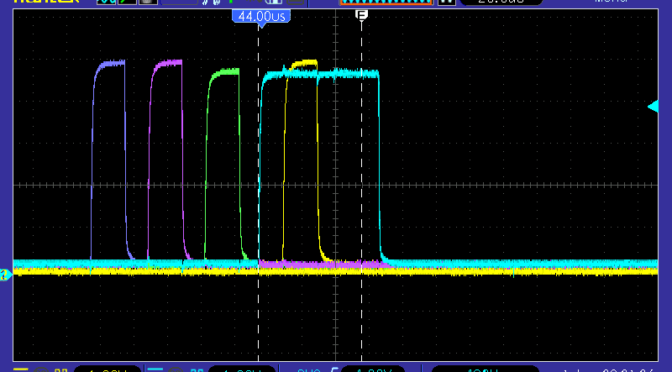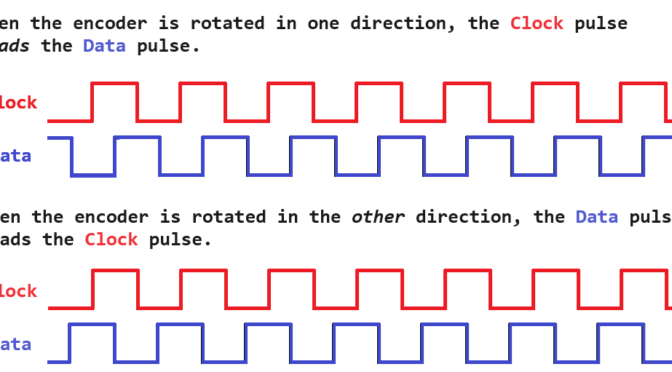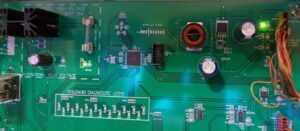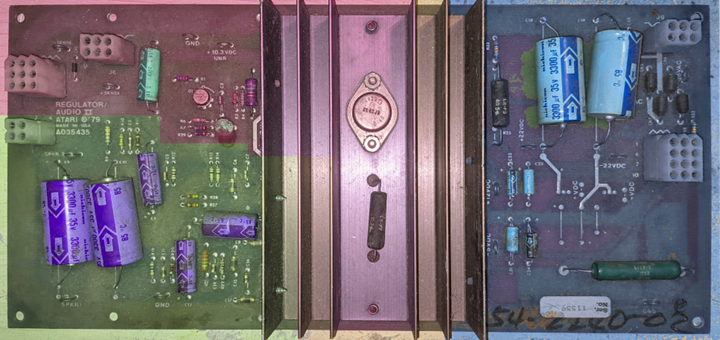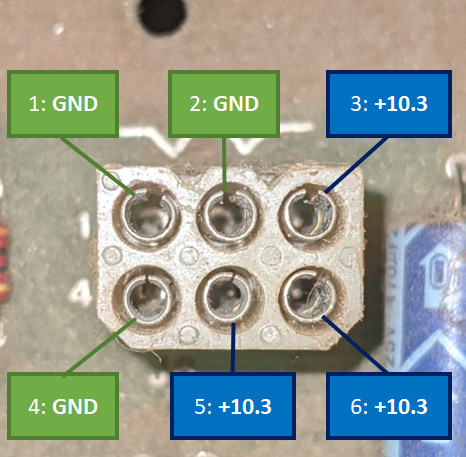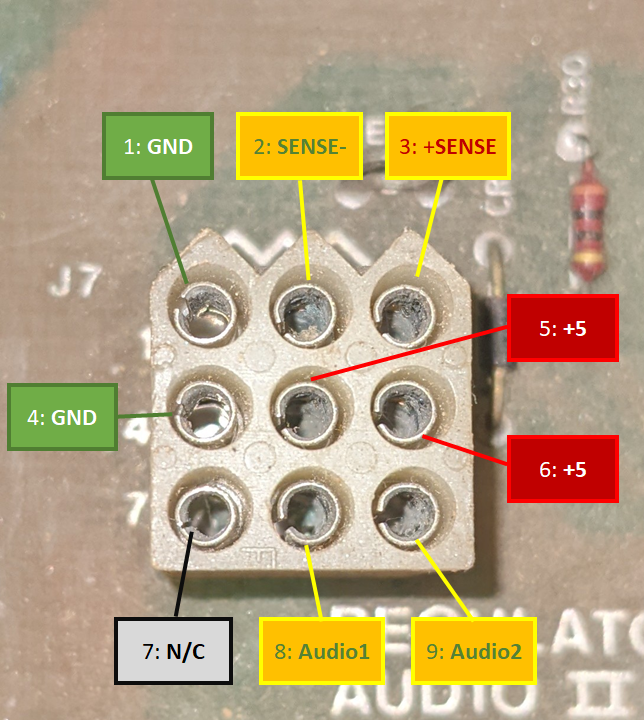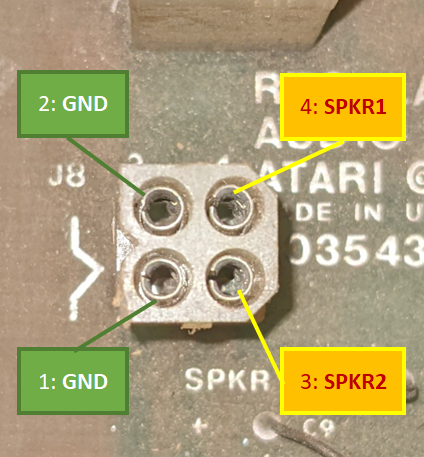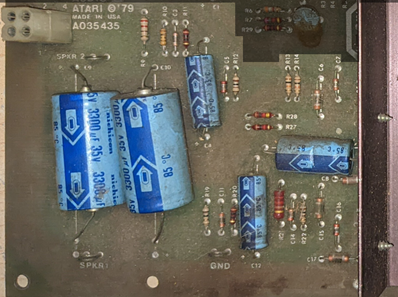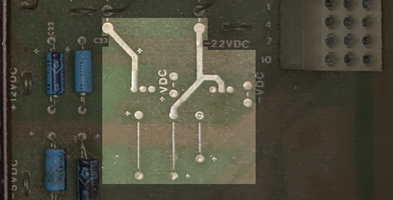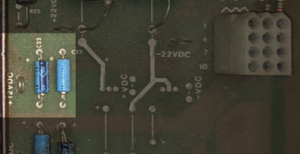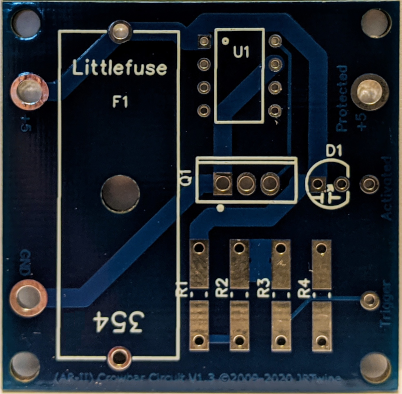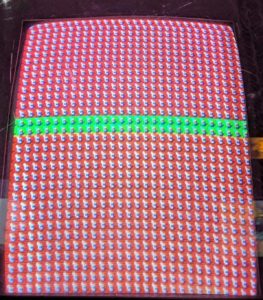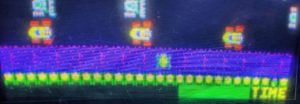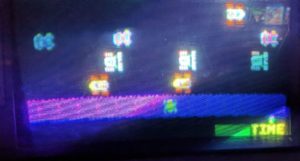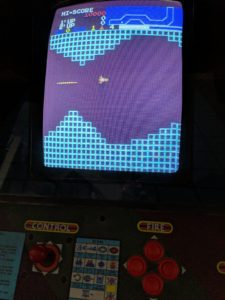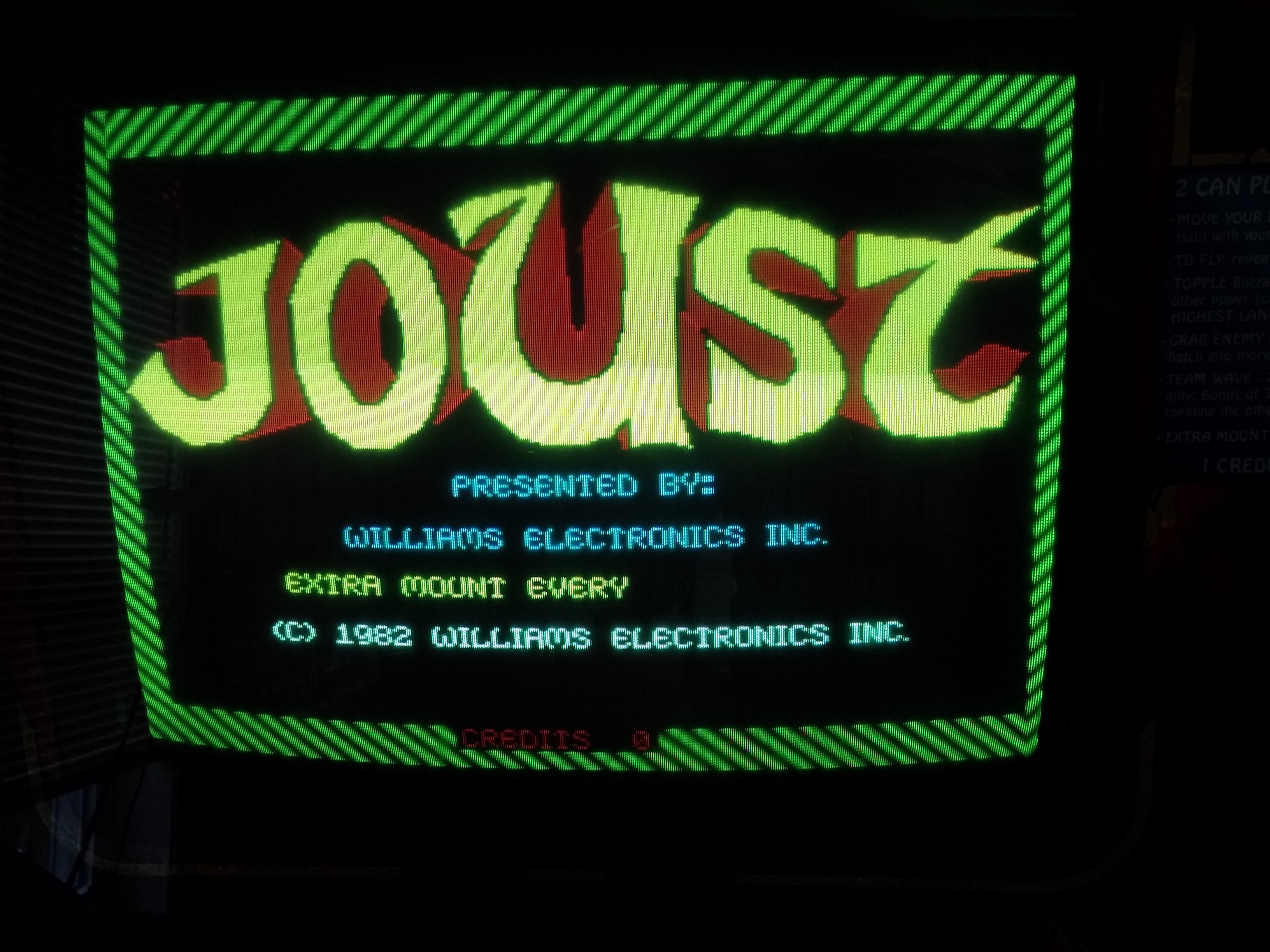I am seeing something across multiple classic Bally pins that makes me think it is an actual bug in the firmware. It has to do with the LATCH signals for the displays. Specifically the Credit/Match/Ball (CMB) display.
Category Archives: Repair Logs
This blog contains my previous Arcade Repair Logs moved to blog format. It is also where new logs will be created.
Quadrature Encoding Refresher
Quadrature Encoding
…is the method used by mechanical mice, trackballs, and spinners like those used on Tempest and Arkanoid. It works by attaching a movement axis to a slotted wheel and placing the slots in between two optoisolators or optos. When talking about Quadrature Encoding, the two signals from the optos are sometimes referred to as Clock and Data.
Alltek Ultimate Solenoid Driver Board with only the +43 VDC LED lit
So I have a stand-alone Mata Hari headboard that is used for testing purposes.
I previously had a Alltek Ultimate Solenoid Driver Board (USDB) in it that was powering an Alltek MPU board. That USDB was pulled because it was needed for another purpose and I later received a new USDB as a replacement. However, after connecting this one up it only lit up its +43 VDC LED. (Actually, it also lit up its 180 VDC LED, but that has nothing to do with this post.)
Continue reading Alltek Ultimate Solenoid Driver Board with only the +43 VDC LED lit
Replacing Bad Customs’ Sockets on Galaga
Had a Galaga that was reporting false ROM errors and had glitching that made me think that the three CPUs were uncoordinated. For example:
- Game would sometimes play but would have no sound, would play glitchy sounds, or get stuck on sounds
- Game would have odd graphics-related issues during its startup or sometimes during play
- Starfield had incorrect behavior – was moving backwards, was stopped, or moving at the wrong speed
Odd Display Issue in Gottlieb Haunted House pin
So I was helping a friend with his Haunted House (HH) pin. The bottom playfield stopped kicking the ball back onto the main playfield, and the two right score displays and the center credit/ball display would distort on a cyclic basis – they would show all segments in a flash-flash-pause, flash-flash-pause pattern, and this happened when the game was in attract mode, test mode, or being played.
The playfield problem was from the three connectors for the bottom playfield not being routed correctly and he accidentally unplugged them when lifting the main playfield – two of the three of them were disconnected. We routed them through the little slot at the back of the bottom playfield, connected everything up and it all started working again. Continue reading Odd Display Issue in Gottlieb Haunted House pin
Newest Version of AR-II Documentation
Atari Regulator/Audio II (AKA the A/R-II) Version -02 Information
By James R. Twine ©2009-2023
References and Source Material
Information is this document is from personal experience with these beasts and some was stole^H^H^H^H^H… um, I mean… inspired… from many sources including official Atari docs (wiring diagrams, schematics) and Internet-based sources from authors that are far smarter than I, including:
- The Real Bob Roberts
- arcade.melchman.net
- https://bitslicer.tripod.com/ar_SENSE _mod.htm
- VAPS
- UKVAC
- rec.games.video.arcade.collecting (yes, I am THAT old)
Legalese
This document’s content was compiled and written by James R. Twine, ©2009-2023. It can be freely shared or even incorporated into other documentation if an accurate attribution is present. OK, now the common sense warning:
Some of the information in this document may be incorrect!!!
The reader (um, that means YOU) assumes all risk of using or misusing this information. I am not responsible if the information in this document results in damage to your A/R-II (R/A-II), damages your game, burns your house down, gets your sister pregnant, kills your dog, causes you to get divorced, etc. By continuing to read this document and/or apply the information contained within, you acknowledge the above and assume all risks of using the information provided.
We Will Start by Just Getting This Out of the Way…
The notorious SENSE mod. The arcade community seems split on this one. Not exactly a 50/50 split, but more people seem to recommend performing the mod. The rest vote for keeping the SENSE circuit intact, and “simply” performing proper maintenance and/or other mods on the game to alleviate the connectors heating up and burning, which is the primary reason for suggesting that one should disable the SENSE circuit.
Personally, I prefer to learn from history – suggesting that one correctly maintain their game and keep their edge connectors clean is great. But we all know that people just do not do it. So personally, I suggest performing the mod, and directions for doing so are included in this document. Besides, I think it is better to find out that your connectors are going bad by a voltage drop causing the game to stop working, not by your connectors getting too hot and deteriorating further.
That said, you will see people talk about “bulletproofing” an A/R-II, and then they simply go about describing the SENSE mod.
THIS IS NOT BULLETPROOFING!
Anyone that says that simply performing the SENSE mod is bulletproofing1 an A/R-II is lying to you or just does not know any better. Why? Because if the +5V regulation fails it is still possible to end up with more than +5V over the +5V line, which could damage any board connected to it. What kind of “bulletproofing” is that? (Shameless plug: that is why I designed a PCB with an adjustable crowbar circuit – THAT is how you bulletproof an A/R-II!) Anyway – rant over… information on an easy way to perform the SENSE mod is shown below where I document connector J7.
Meet the Atari Regulator/Audio II (mod -02)
This component, affectionately referred to as the A/R-II (“A Are Two” even though calling it the R/A-II would be more correct) was used in many of Atari’s games from the ‘70s and ‘80s. It exists in various forms, from the original Regulator/Audio board used in early B/W games like Asteroids and Atari Football, to the Regulator/Audio II used in many different color games to about the mid ‘80s (e.g. Centipede, Dig Dug, Kangaroo, Missile Command, Pole Position, Tempest, etc.), to the Regulator/Audio III.
Its primary purpose was to supply necessary voltages for the game (logic, audio, and sometimes things like the odd voltages required to erase an EAROM), as well as provide audio amplification. Different versions of the board provided different features like different voltages, more amperage, etc. The image below shows a -02 version.
The board can be roughly divided into 3 areas that are shaded purple, green, and blue in the above image. The middle and upper-left areas are +5V regulation, the lower-left is audio amplification, and the right side is secondary voltages (-5V, +12V, and +/-22V). It is worth mentioning that both “halves” of the board are logically separate. You can apply power to only the left side and get your +5V and audio amps. And you can apply power to only the right side and get your secondary voltages. Both sides do not have to be powered up at the same time.
The connectors are consistent between other versions and revisions of the board, so it may be possible to substitute one for the other depending on the voltages and/or features required. For example, a -03 can usually be used to replace a -02.
Connectors
We will go through the connectors in order of their designations.
J6 – Main Power Input
This connector supplies the power required to produce the regulated +5V and power the audio amps. Note that the +10.3VDC input is unregulated and may normally measure a couple of volts higher when not loaded, such as if you meter it directly on the power brick.
J7 – Main Power Output and Audio Input
This connector supplies the regulated +5V as well as the SENSE lines. It also is where unamplified audio comes into the board.
SENSE Circuit Description and the SENSE Mod
So, how about we stop here for a second to talk about SENSE. You may have heard of the infamous SENSE circuit on these boards, but what does it really do? Well, it is supposed to detect a voltage drop between the power supply and the game’s board. On the game’s PCB the +5V is routed to +SENSE, and GND (the +5V return) is connected to -SENSE. The A/R board uses the voltage coming back on the SENSE lines to determine if it needs to bump up the voltage to compensate for any voltage drop that occurred on the way to the game’s PCB (though the wires, connectors, etc.). Sounds like a good idea at first, right?
Well, now throw in a failing +5V connection to the board – like a dirty connection or a physically failing one. As more and more voltage is lost, the SENSE circuit will keep boosting the voltage, which can lead to overheating and exacerbate the failing connection. Remember that the +5V and +SENSE are connected on the game board? Well, if the +5V connection fails badly enough, the game might try to draw current over the +SENSE line. This is the cause of the infamous smoking of R30 (and sometimes R29) – the game is trying to draw multiple amps across that poor little ¼ or ½ watt resistor.
So, the SENSE mod tricks the SENSE circuit into always seeing exactly what the A/R board is putting out. This is done by connecting +5V and +SENSE together, and GND and -SENSE together, on the A/R board itself. The easiest(?) way to do this is to turn the A/R board over and solder a jumper between pins 1 and 2, and another one between 3 and 6 on connector J7. Note that after doing this, you may have to manually adjust the +5V pot to get a solid +5V at the game board.
It is also worth noting that if you ever need to bench test the board or adjust the voltage using the pot at R8, make sure that the +SENSE line is connected back to the +5V line either via the mod or by connecting-up a game board. The +SENSE line is what is connected to the feedback input on the +5V regulator and and this feedback circuit is necessary for the board to work correctly. If you think you will be benching a lot of these boards, it may be worth created a plug that mates with J7 and wires-up the SENSE lines accordingly.
J8 – Speaker (Amplified Audio) Output
This is the amplified audio (Speaker) connection. If you are used to seeing positive and negative speaker signals, consider the SPKR1 and SPKR2 signals to be the positive ones, and the GND to be the negative ones.
J9 – Secondary Power Input
This connector provides the 36VAC (note – AC, not DC like on J6!) input voltage to the board which is necessary to generate the additional +12, +/-22, +/-15, and -5 voltages. Not all A/R boards are stuffed to produce all the secondary voltages. On the board shown in this document, the area that would be used to produce the +/-15V is unpopulated.
J10 – Secondary Voltage Output
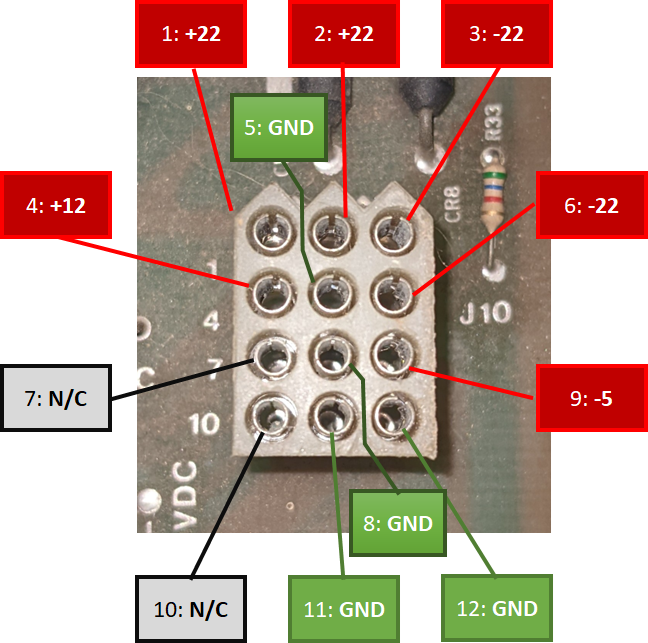
This connector provides the additional voltages produced from the 36VAC provided on connector J9. (Pins 7 and 10 would be the +/-15V if it was present on this board.) Also note that the +/-22V is unregulated and directly connected to the bridge’s filtered output, so do not be surprised if you see a higher voltage when unloaded.
Operation
Here I will try to describe how this A/R board works.
Primary +5V SupplyThe primary +5V supply derives from the Excessive voltage or no voltage on the |
Audio AmplifiersAudio amplification is provided by the two TDA2002(AV) amplifiers. If you are having problems with distorted sound, I would start with the two larger output coupling caps, C9 (SPKR1) and C10 (SPKR2) before looking at the amplifiers themselves.
|
Troubleshooting
This section covers a few things that might help with troubleshooting and repair of an A/R-II.
First is a good adjustable power supply to produce the +10.3V for the primary side and either a transformer that will output ~36VAC or a variable one for the 36VAC for the secondary side. I recommend working with one side at a time.
Next is to get a good quality 2-ohm, 20 W cermet resistor. When briefly connected between +5V and GND it will pull 2.5 amps and I believe this is a suitable load to test the +5V line with.
If testing on a bench, be sure to either have the sense mod performed or jumper together the +SENSE+5V-SENSEGND
Problem/Symptom |
Possible Cause(s) |
+5V is present and seems stable when measured while unloaded but drops to a much lower voltage when loaded. |
1. The 5V regulator may have failed.
2. The 5V regulator is working, but the board cannot provide the additional current that would normally be provided via Q2 and/or Q3, so one or both may have failed (likely just Q3). |
No +5V present, audio amplification seems to be working. |
1. This could mean that the 5V regulator has failed.
2. This could mean that the 5V regulator is working, but the board cannot provide the additional current that would normally be provided via Q2 and/or Q3, so one or both may have failed (likely just Q3). |
No +5V and no audio amplification. |
Check 10.3VDC input and fuses on power brick. |
| One or more audio channels is not working. | The amplifier for that audio channel may have failed – the TDA2002 at Q5 for SPKR1 and/or the one at Q7 for SPKR2. |
| One or more audio channels are distorted. | The output coupling cap for that audio channel may be leaky and need to be replaced – C9 for SPKR1 and/or C10 for SPKR2. |
+5V has excessive ripple present or the game is experiencing excessive crashes, resets, visual artifacts, odd behaviors, etc. Sometimes an audio hum can also be heard. |
Check the large filtering capacitor (the “Big Blue”) on the power brick. |
Secondary voltages have excessive ripple present (especially noticeable on the +/-22V). |
Check the two large filtering capacitors on the right side of the board – C18 and C19. |
| Secondary voltages are missing a polarity or a reduction in output is voltage is present | One or more of the diodes that comprise the full-wave bridge rectifier on the right side of the board may have failed – CR5, CR6, CR7 or CR8. |
| Missing one or more of the regulated secondary voltages. | The regulator for the associated voltage may have failed – the 7905 for the -5, or the 7812 for the +12. |
| Pulling too much current on the 36VAC (blown fuses). | One or more diodes in the bridge may have shorted – CR5, CR6, CR7 or CR8. |
Component Layout and Parts List
The following is a redrawn parts layout for this A/R-II board. Location may not be precise or exact down to a millimeter but should allow you to locate and identify components of interest. A parts list is also included.
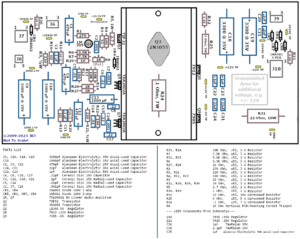
Modifications
Converting a -02 to -03
The version -03 of the AR-II is almost identical to the -02 but with a few changes for the increased current demands of Missile Command (and Monte Carlo?). The differences are:
R25 – a 4 ohm 5W resistor, is replaced with a jumper (or you might see a black zero-ohm resistor)
R31 – a 22 ohm 10W resistor is replaced with a 15 ohm resistor
This also means that you should be able to safely substitute a -03 for an -02 if necessary.
[1] You do not wear a bulletproof vest to prevent things from going wrong, you wear one for when things do go wrong. If you are not able to completely prevent or robustly handle a catastrophic failure, I would suggest that you are not bulletproofing.
Schematic
Here is a mostly searchable PDF of the schematic: AR-IISchematic(OCR)
Galaga Board with Enhancement Pack not Booting
I finally got around to working on a Galaga board for AM and I got it up and running and was leaving it on for a 24-hour test when it crapped out showing a error on ROM 39 (which does not exist). This eventually degraded into a state where it did not display any errors at all, and just seem to hang up at the nonvolatile memory test (NVM OK), and started playing random sounds.
Continue reading Galaga Board with Enhancement Pack not Booting
Theory of Operation of the Shaq 27722-1 (A23) LED Display Board
Theory of Operation of the Shaq 27722-1 (A23) LED Display Board (4-player score board).Theory of Operation of the Shaq 27722-1 (A23) LED Display Board (4-player score board).
Theory of Operation
This is a brief technical introduction to the operation of the 27722-1 (A23) board. It will cover inputs and behavior of the board.
Inputs
This board accepts the following three control inputs:
- Master Reset (/MR)
- 8-Bit Data (DX0–DX7 – pulled up to +5v/VCC)
- Enable/Strobe for the latches (AX4)
It also accepts +5, common GND, +12 and the +12V GND (both GNDs are connected together).
The incoming 8-bit data is split into two 4-bit words with the low word (DX0–DX3) used for specifying the value to display on a particular LED digit via the ‘4511 (BCD to 7-segment latch/decoder/driver), with DX0, DX1, DX2 and DX3 connected to inputs A, B, C and D (or D1, D2, D3, and D4), respectively. The high word (DX4–DX7) is used for digit selection via the ‘4514 (4 to 16-Line Latch/Decoder/Demultiplexer), with DX4, DX5, DX6 and DX7 connected to inputs A, B, C and D, respectively.
Latches for the corresponding chips are controlled via the AX4 signal, which is directly connected to the 4511’s /LE input and also goes through an inverter whose output is connected to the 4514’s LE.
The /MR signal is connected to the 4511’s /BI signal, which is used to blank the displays whenever the game is in reset.
Continue reading Theory of Operation of the Shaq 27722-1 (A23) LED Display Board
Pac-Man With Strange RAM Issue
So I was working on a Pac board for a friend that was dying at boot with symptoms of bad VRAM. I swapped out all of the RAMs only to have the problem persist. Continue reading Pac-Man With Strange RAM Issue
Can you “Bulletproof” an Atari AR-II Power Supply? I Think I Can…
Well, like the title initially asks, can you really “bulletproof” an Atari AR-II board? From what I have found on the Internet, and older material like Star Tech Journals, the answer really is no. Pretty much all sources that mention “bulletproof” and “AR-II” on the same page are only taking about performing the Sense mods, and nothing else.
A small amount of pages mention replacing parts (caps, regulators, etc.) due to their age, but that is not bulletproofing either – that is just a good idea. But I think I can actually bulletproof it, and maybe other power supplies as well.
Continue reading Can you “Bulletproof” an Atari AR-II Power Supply? I Think I Can…
WG6100 w/Tempest Showing a Tangled Mess in the Bottom Right Quadrant
So this is basically the second part of a previous post about a tempest that lost deflection.
After running for a while that Tempest’s display changed into something that can only be described as a tangled mess:
That is something that I never had seen before. The owner turned the game off and back on again later that day and it was working normally. Then it would get screwed up again.
Continue reading WG6100 w/Tempest Showing a Tangled Mess in the Bottom Right Quadrant
WG6100 w/Tempest Showing a Multicolored spot in Center of Screen
So I was helping a newly minted arcade game owner when his first purchase, which is his favorite arcade game: Tempest. Shortly after getting it the X-Size pot fell apart and the game ended up only showing a Multicolored spot (larger than a just a “dot”) which changed depending on what the game was doing. We soldered in a larger replacement (dangling from some wires) but while this did change the display a little when the pot was articulated, it did not fix the problem.
He had joined a FB arcade repair group and asked for help there and ended up with ideas ranging from his brightness being too high (it was not – I think the person that responded thought the game was drawing normally but with retrace lines and a white dot in the middle, kind of like how it looks when you’re drawing on an oscilloscope with no Z input), voltages too low (they were not), and one even going down the path of impending AR-II failure(!) and going on about replacing leaky sense resistors and the bottlecap transistor. Oy vey!
Continue reading WG6100 w/Tempest Showing a Multicolored spot in Center of Screen
Lithium Battery Replacement for Williams and other CMOS Systems
So you have decided to reduce the risk of battery leakage damaging your precious Williams arcade or pinball board by replacing the existing AA batteries with a lithium (CR2032) replacement. Great! Lithium batteries like the CR2032 tend to leak much less than alkaline batteries so this is a good generally a good idea.
Note that I said “much less than alkaline batteries“ – lithium batteries can still leak causing damage to your PCB!
You need to maintain them like any other battery system.
So now the question is, how long will the lithium battery last before it needs to be replaced? I would suggest that you replace the battery as soon as it voltage-under-load drops to 2.8v. Why 2.8? Two good reasons. First, here is a discharge graph pulled from the Energizer CR2032 datasheet: Continue reading Lithium Battery Replacement for Williams and other CMOS Systems
+43 Volt Error on a Alltek Systems Replacement MPU Board
![]() So I was helping another collector in the area try to get a Bally Star Trek Pinball running. It had a Alltek MPU replacement board it in that would start to boot but then stop with 5 diagnostic flashes which indicate a problem with the +43v supply. However, when metered at the test point, the +43v looked grossly normal.
So I was helping another collector in the area try to get a Bally Star Trek Pinball running. It had a Alltek MPU replacement board it in that would start to boot but then stop with 5 diagnostic flashes which indicate a problem with the +43v supply. However, when metered at the test point, the +43v looked grossly normal.
Got in touch with Alltek Systems support and the person suggested disconnecting the sound board and seeing what happened. The game came up with it disconnected, and the support person said there was something wrong with the +43v stuff on the sound board. Right where it comes in there is a diode (CR3) that the collector tested open one way, and about 94k ohms the other.
So a good diagnostic step for this kind of hardware, perhaps even with the original boards in it, is to completely disconnect the sound board and see if the behavior of the game changes.
Update: when I returned to that collector’s house, we lifted one end of the diode and tested it again. Tested open one way but with a lower-than-expected forward voltage drop of about .350v where we expected more for a standard 1N4004 diode. I called it bad and pulled the diode. Had the collector solder in a replacement and the Star Trek came right up!
Frogger Problems
So I visited the arcade of someone I have come to know and while taking a look around and playing a few games, I stumbled across this screen on a Frogger:
Not exactly playable, if you catch my drift. Went over the usual stuff, power, reseating, etc. Voltage was a little low, and the power supply could use some maintenance because of a bit of ripple. But was able to get it back up again. When it booted, it booted into an odd screen and I realized it had some kind of HS kit in it. This was actually nice because it included a RAM and ROM test that showed everything passed.
Went into the game and coined it up to play, and saw this:
Pretty sure that we do not want that many lives per game. Seeing that this was a pretty strange issue, I thought to reconfigure things in the HS kit. After readjusting things to 3 lives per game, saving the changes and restarting the game:
Much better, eh?
After fixing something, always be sure to actually try to play it and make sure everything is working right.
Galaga/Bosconian RAM Tip
Galaga uses 4-bit RAMs. This means that in order to handle 8-bit data, it needs to group RAMs in sets of 2 – one for the lower 4 bits, and the other for the higher 4 bits. When Galaga detects a RAM error during the self-test, it does not show the location of the failed RAM, they shows which RAM failed. Continue reading Galaga/Bosconian RAM Tip
Dead Vanguard Board
So I came across a dead Vanguard that was for sale. Described as only producing a boom sound effect and then a rumbling/static-y noise. Bought the thing home along with 1.5 spare boards and did the usual checks: Power, Sockets (reseat), etc. Logic probe on the CPU indicated that it was briefly running and then getting hung up and it looks like there is no watchdog on this game. The sounds being made were from the sound board, which produces its noises without the main CPU being present at all.
Power takes a little longer than I would like to stabilize (several seconds), and was a tad low on the board, but adjusting it did not change anything. It looks like the factory switching supply so it likely could use a cap job.
I got memory map information from MAME to try to figure out the memory map, and got a manual for the game. The manual actually includes a memory map as well as which RAM chips are use in which RAM areas, which is really nice.
Connected up the Fluke 9010 and hit the Learn function. When it was done, I noticed that the results did not match the memory map in the manual. The first RAM section (CPU Work RAM) was not identified at all. Turns out that section had stuck bits (2 & 3). Replaced the socket and the RAM and the game mostly roared to life, with the exception of the power stabilization issue – it takes a few seconds after being initially powered on before the game will run stable so you have to cycle power several seconds after initially powering it up. Monitor could use a cap kit but is in decent condition for its age.
Gonna hit that second board in the near future, initial tests show bit 8 is stuck high.
Williams Hardware, Switchers and CMOS
So this keeps coming up a few times a year, almost like people completely forget about how to use Google every now and then.
Someone has a Williams 6809 hardware game like Defender, Stargate, Joust, etc. They install a switcher instead of repairing the existing linear supply (which is OK, people have their reasons), and everything works great, except for the fact that they occasionally get CMOS corruption and lose things like settings, bookeeping, and scores.
Is something wrong with the switcher? No, something is just wrong with the CPU.
Watchdogging and Corrupted Centipede (Bad POKEY)
Got to work on a busted Centipede that booted to a white background screen that briefly showed the start of the attract mode (things drawn in green or purple) before crashing, watchdogging and doing it all over again. Test mode would do the same thing as well.
Disabling the watchdog (by grounding the WDDIS test point) did not help as the game would just essentially do the same things but just not reset after it crashed.
Continue reading Watchdogging and Corrupted Centipede (Bad POKEY)
Dead Gorf
So I found a dead Gorf on Craigslist. It was an older ad, but was still available when I inquired. Dude I picked it up from had done some pretty impressive restorations on some other games.
Anyway – it was dead alright. Shows a blank screen that looked overly blue due to how the monitor was adjusted, no starfield was visible. Slid the test switch over and power-cycled, but this made no difference either.
The previous owner had mentioned that he had done some work on it. I saw some of his other previous work on other boards of his and while not perfect (some cold joints, or not enough solder in some places leaving “pits”), it was not horrible and definitely no worse than what I was doing when I started out.
Anyhoo, starting with the power PCB – the previous owner said he had already replaced the caps, but I wanted a second look at it, JIC. On the solder side of the board, some larger traces has been lifted off the board during some previous repair work (I do not think it was his, maybe someone before him?).
It looked like the someone used a serious soldering gun to do the work, because there were scorch marks on the board(!) and flux was all over the older work too. Continuity was where it was supposed to be, so I guess that while it was ugly, it worked. Continue reading Dead Gorf
Bringing Joust Back to Life
So it came to pass that I ended up with three cabinets for $100 each. A Great Golf in a Midway cabaret, some Toaplan run-n-gun in a Taito Qix cabinet, and… A Joust(!) in its original cabinet.
I agreed to purchase all three sight-unseen. When I get them all home, the golf game worked except for a rolling screen, the run-n-gun has an board issue where some sprites are being displayed at the wrong horizontal locations, and the Joust?
Well, the Joust was dead. Simple static video (monitor needs a cap kit, too), watchdog barking, no response to inputs, nothing on the LED on the ROM board.
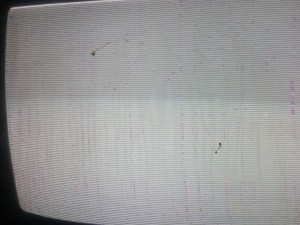
Joust Showing 1 3 5 and a REALLY Effed-Up Screen
[This was extracted from a large article about getting a dead Joust operational. I thought it made sense to put this part in its own post to help anyone else with a similar issue. This post may reference content from an earlier post, so keep that in mind when reading.]
So at this point the Joust will run through its self-tests, show 1 3 5 on the LED, and will eventually enter attract mode and can even be coined up and it will play for a few seconds before crashing again. While the screen is AFU, you can actually read text on it if you look carefully (just turn the audio off). Pay attention to how the left 1/3 screen is being drawn differently than the rest – this becomes important later:
Continue reading Joust Showing 1 3 5 and a REALLY Effed-Up Screen
Joust With an Input Problem – 1st Player Always Runs Left
[This was extracted from a large article about getting a dead Joust operational. I thought it made sense to put this part in its own post to help anyone else with a similar issue. It may reference content from the previous two posts here and here.]
…So now I have a Joust that boots correctly and comes up into its attract mode normally. However, after coining it up and starting a game, I still have some issues – player 1 starts running to the left non-stop!
Opening the control panel shows the switch is not stuck, and disconnecting its harness did not change the behavior, so I have another board-level issue to resolve. The input board multiplexes two sets of switches into a 6821 PIA, and the switches come in through one of two header connectors on the board.
Continue reading Joust With an Input Problem – 1st Player Always Runs Left
Sanyo 20EZ Video Inversion (Parts Kit) Searchable Page
On Bob Roberts site, there is (or was, if the link is broken by the time you read this) a scan of a page that details how to add the missing parts to the Sanyo 20-EZ monitor chassis to allow it to perform video inversion. Since the page was scanned and not run through an OCR process, the text is not searchable. As a service to the arcade collecting/repair community, I provide this HTML based, searchable version of the document.
(Note that I am not responsible for the use or misuse of this information, and I might have copied something incorrectly! No warranties expressed or implied, and the risk of use lies with YOU! YMMV.) Continue reading Sanyo 20EZ Video Inversion (Parts Kit) Searchable Page
Merit Megatouch 5 Issues
Offered to help out a friend whose husband had an upright Megatouch 5 (CRT-260 motherboard) that had some issues:
- Would randomly crash when touching the touchscreen
- Would randomly hang or crash even when left alone
- After left running for a little while (like, 15 minutes) calibration would “drift,” causing touches to track incorrectly
After opening it up, the touchscreen was covered in dust and the neoprene strips on the edges of it were pretty torn up and had a bunch of debris on them. Cleaning the screen, strips, and then reapplying the strips with some thin double-sided tape cleared up the touch-the-screen-and-it-dies problem. Continue reading Merit Megatouch 5 Issues
Hopper Error (HE) on Sammy Aladdin Pachislo Machine
I picked this one up last year with a generic E1 error code for $50. Reseating all connectors and performing a master reset (reset key in and turned, internal power switch cycled, reset key removed) brought it right up. Been working fine for a little over a year then the hopper quit working. Display would show “HE” when it tried to spit out tokens.
Removed hopper and inspected it – nothing jammed up, and all switches/optos in the bottom were functioning correctly. When the hopper is started (using the switch within the cabinet), it moves just a slight amount. Removing the motor shows that the motor spins about 1/3-1/4 rotation and then stops, with no resistance on the gear/spindle when I turn it manually. If I leave the motor powered, I can start to smell that electrical smell that tells me something is bad within the motor. Continue reading Hopper Error (HE) on Sammy Aladdin Pachislo Machine
Dig Dug with Floating Pins
Going through my boards, I came across a second Dig Dug board. This one boots to static garbage and no sound. Watchdog is barking.
Removing one of the CPUs gets different garbage. Tried replacing with a known good one, no change.
Checking the pins shows me that a couple of the data lines, from D3 to D6 (I cannot remember which ones right now) are completely floating! Rarely see that. On a hunch, I replace the CPU’s socket, but this changes nothing.
Board traces go two a few chips (a 7474 and some other multiplexers or demultiplexers), and the floating lines seem to follow them. But following the traces is tricky, so I gotta dig up some schematics to see what the Hell is going on.
Roc’N Rope PCB Issues
Got an interesting problem with a Roc’N Rope board that I recently connected up to the new JAMMA test rig. It has all its sounds, and plays correctly, but the text and tiles (e.g. the title graphics and the graphics used to build the levels) are all upside-down!

When the screen is flipped for cocktail mode, the text/tiles are still upside down.
Going digging through the schematics to see what’s what…
Update!
Mark Spaeth gave me a lead on a couple chips on the board that may be the cause of the problem. That, combined with the schematics lead me to find out that I had a 74174 with a stuck output (pin 10). I first clipped and lifted the pin for that specific output to ensure that nothing else was pulling the output and confirmed that the chip was bad.
After clipping and desoldering the chip and replacing it with a socketed NOS 74174, all of the text and tiles are right side up again!
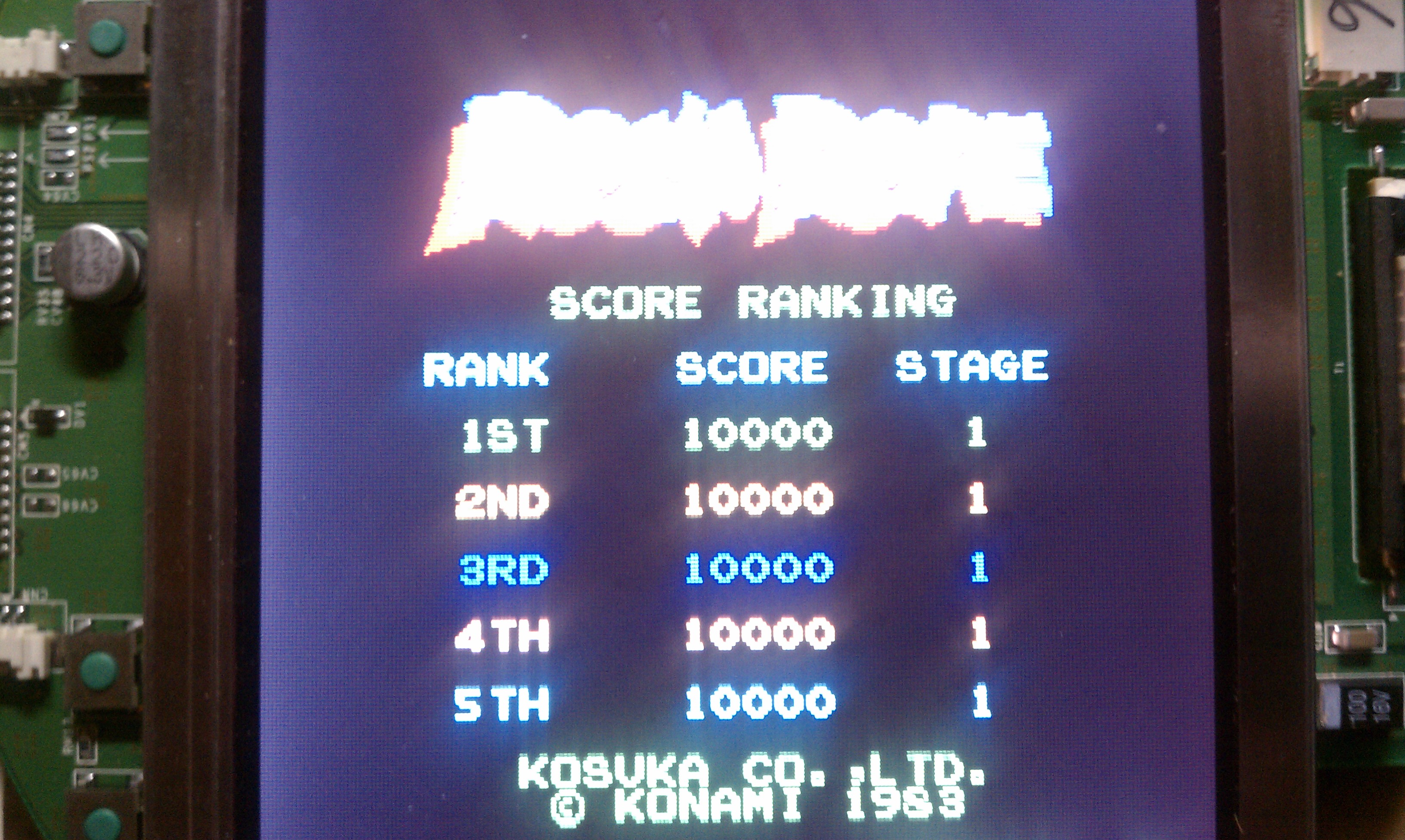
Also, I found out that I have another RnR board, this one with a graphics issue involving the sprites. Should be able to get that one fixed as well, and then I will have two original RnR boards (both with their original serial number stickers on ’em).
OK – this other RnR board just had to have some of its chips cleaned and/or reseated. It is looking good now as well:

Nutshell: Flipped tiles and text, cause was a 74174 at location G15 with a stuck output @ pin 10.
Centipede Cocktails — Cocktail #2
My previous post, about Cocktail #1, clearly documents the “easy one.” This second one is gonna be another story. It has a very dead monitor, and a non-functional board. I have not yet benched the monitor, but it has no neck glow, which is never a good sign.
The board has problems, but at least I know it is not the CPU as I already swapped it, and I know that it is not a power problem on the second Cocktail, because the board has the same behavior in Cocktail #1.
Swapped all socketed chips to no effect — they all work on the other board. Power points seemed right on the board, but I put it into my working cabinet to verify… and while doing so I managed to cross GND with a +5v trace and smoked R30 quite nicely on my AR-II board.
I have replaced it, but am still getting voltages that are too high. Gonna have to hunt other likley suspects…
As far as the board goes, I am gonna have to break out the Fluke 9010 to work on this one… Right after building an adapter for it so I cam power it up on the bench.
The monitor I should know more about once I have it on the bench and take a good look at it while I am capping it (and doing the sync upgrade).
—–
Turns out that this one had a cracked flyback. I ordered a replacement kit (flyback and caps) from The Real Bob Roberts and replaced the flyback (my first flyback replacement!). Have not yet put it back into the game and fired it up, though. Maybe after winter…
Centipede Cocktails — Cocktail #1
Well, I ended up taking two Centipede cocktails off of another local collector as a package deal. Still want that Gorf, though… Will have to come back to that one soon!
But I digress… So I have two Centipede cocktails here. One of them has a dead monitor (and a non-working board, I later discovered), and the other will not sync:
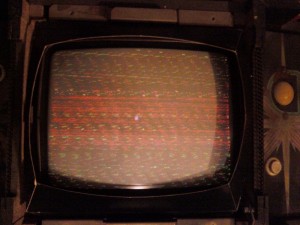
(Note how dirty the control panel is, as well as the color of the button and trackball to compare with another picture later in this post.) Checked the wiring, the connectors, adjustments/controls and nothing would get it right, so I went to capping it. Here is a picture of it half way done on my bench:
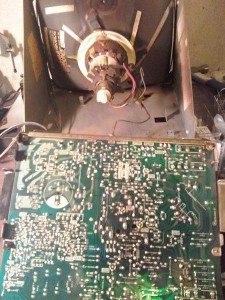
After capping it (and also doing the sync improvement upgrade while I was there), all it took was a few adjustments and the screen came up sharp and clear. This image also shows one of the rebuilt trackballs, which is now running as smooth as when it came out of the crate:
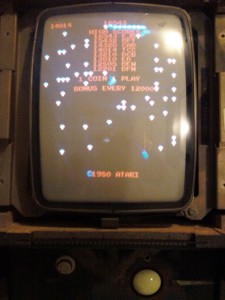
The text looks a bit blurry, but only in the picture. The screen is really sharp! You can also see a new shiny trackball at the bottom too. Next to it is a really dirty button. Here is one of the panels (from the other cocktail, because its panels are in better condition) with a replacement button and a (unmounted) rebuilt trackball after being cleaned up a bit:
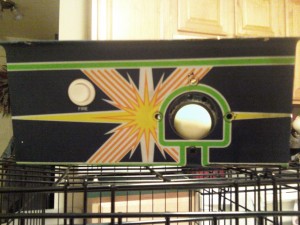
All in all, not bad for about 3 or so hours of work, if I do say so myself. (3 hours for everything, not just cleaning this panel! 🙂
Now, that other cocktail… that one is gonna be a bit harder…
